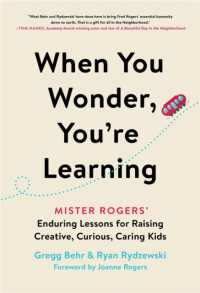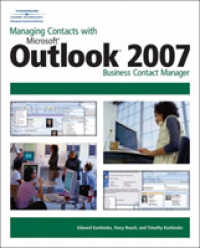Full Description
Expand your teaching repertoire with this unique collection of instructional ideas. Author Frank T. Lyman Jr., esteemed educator and creator of the Think-Pair-Share model, offers ways to help students think critically, encounter puzzling phenomena and seek explanations, think before responding, listen to responses from others, create their own questions, visualize a scene, employ problem-solving strategies, and more.
Appropriate for teachers of all grades and subjects, the ideas address the pursuit of true learning—wanting to learn, how to learn, and enabling to learn—and can easily be adapted and applied to a wide variety of contexts.
The book's format allows you to pick and choose activities for your own professional development journey and make them your own, so you can expand your teaching toolbox and bring more students to deeper levels of learning.
Contents
SECTION I Learning to Learn—the Student as Aware and Persevering Thinker
1 Inspire to Inquire 2 Connectors of the Mind 3 Enfranchise Student Minds 4 Teach Them Metacognition 5 A Cognitive Path to Solutions 6 Linking the Thinking 7 Student Experts 8 Students as Knowledge Makers 9 Decisions—Rationales and Consequences 10 Ask Me a Question 11 Mind Hopping 12 The Learning Theory Lab 13 Work on Attitude 14 The Seemly Side 15 Habits of Mind and Conscience 16 Metastrategics 17 Not the Answer but the Plan 18 Teach Students How to Teach 19 Let Students Be Rule Makers 20 Student Test Making 21 Note Making 22 Hear It, See It, Say It, Beat It, Write It, Drop It 23 Spell With Two L's
SECTION II Literacy—The Student as Reader, Writer, Speaker, and Listener
24 Unfluff Their Brains; Read to Them 25 Reading as Seeing With Hearing 26 Comprehension or Memory? 27 Novel Beginnings 28 Verse Power 29 Poetry and Memory 30 Books—the Classroom Currency 31 Book Reports 32 Teach Through Stories 33 Biblioallusions 34 The Reading Wheel 35 Repeat for Fluency 36 Character Relationship Analogies 37 People Links 38 The Story Theater Chain 39 "Why Not Let Them All Act?" 40 What to Write About: A Personal Question 41 History Writing 42 Use Parallel Plots 43 "Transprose" to Poetry 44 Problem-Centered Story Design 45 Teach Craft Through Models in Expository Writing 46 The Verve of the Verb 47 Recreating Scenes 48 See It, Be It, Feel It 49 Metaphor Training 50 Essay Essence 51 Essay Design 52 Model Quality by Excerpt Publishing 53 Let Words Define Themselves 54 See the Sentence 55 Deconstruct and Reconstruct 56 The Handwriting Game 57 Foreign Language Interest
SECTION III The Voice of the Student—Honoring and Motivating the Individual
58 Relevance 59 Class Building Through Weird Facts 60 Cooperative Learning 61 Be Charlotte to Their Wilbur 62 Every Morning an Itinerary 63 Bring Forward the Big Ideas 64 Response-in-Kind 65 When Students Talk, Take Notes 66 Conversations That Last 67 Affect, Its Effect 68 Catch Correctness and Goodness 69 Test for What They Know, Not for How Well They Decipher the Question 70 Assessment Through Visuals 71 Make Math Talk Concrete 72 Walk a Mile in Another's Shoes 73 Mistake Collecting 74 Bridge In and Out 75 Schoolwork at Home 76 Know Thyself 77 Avoiding the Deadly Intersection 78 Beware of Myths 128
SECTION IV Banks of the River—Classroom Flow for the Engagement of All Students
79 A River Needs Banks to Flow 80 Every-Student-Response 81 Planning by Template 82 Allow Think Time After a Question; This Isn't "Jeopardy" 83 All the Wait Times 84 Setting of the Cornerstone 85 Whole Before Part 86 Think-Pair-Share. . . 87 Put it Into Hands 88 Be Neither Concrete nor Abstract: Be Connected 89 Translate 90 Wake the Kingdom: Make Expectations Clear 91 Student Learning Seconds Lost 92 Metering 93 Ride the Wave 94 Keep the Horse in the Barn 95 Old-Fashioned Seating, With a Twist 96 The Nine A.M. Letter 97 Notice Students at Beginnings, Endings, and Outside 98 Outside of Business 99 Punish Not All for the Sins of the Few 100 When All Else Has Failed








